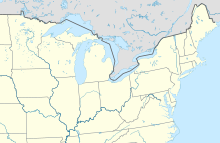
Back Slag van Trenton AF معركة ترينتون Arabic ترنتون دؤیوشو AZB Битка за Трентън Bulgarian Batalla de Trenton Catalan Bitva o Trenton Czech Slaget ved Trenton Danish Schlacht von Trenton German Batalo de Trenton EO Batalla de Trenton Spanish
| Battle of Trenton | |||||||
|---|---|---|---|---|---|---|---|
| Part of the New York and New Jersey campaign | |||||||
 Battle of Trenton, a 1975 portrait of the battle by H. Charles McBarron Jr. | |||||||
| |||||||
| Belligerents | |||||||
|
|
| ||||||
| Commanders and leaders | |||||||
|
|
| ||||||
| Strength | |||||||
| 2,400[2] | 1,500[3] | ||||||
| Casualties and losses | |||||||
|
2 dead from exposure 5 wounded[4] |
22 killed 83 wounded 800–900 captured[5] | ||||||
Location within USA Midwest and Northeast | |||||||
The Battle of Trenton was a small but pivotal American Revolutionary War battle on the morning of December 26, 1776, in Trenton, New Jersey. After General George Washington's crossing of the Delaware River north of Trenton the previous night, Washington led the main body of the Continental Army against Hessian auxiliaries garrisoned at Trenton. After a brief battle, almost two-thirds of the Hessian force were captured, with negligible losses to the Americans. The battle significantly boosted the Continental Army's waning morale, and inspired re-enlistments.
The Continental Army had previously suffered several defeats in New York and had been forced to retreat through New Jersey to Pennsylvania. Morale in the army was low; to end the year on a positive note, George Washington, Commander-in-Chief of the Continental Army, devised a plan to cross the Delaware River on the night of December 25–26 (Christmas and St. Stephen's Day)[6] and surround the Hessians' garrison.
Because the river was icy and the weather severe, the crossing proved dangerous. Two detachments were unable to cross the river, leaving Washington with only 2,400 men under his command in the assault, 3,000 fewer than planned. The army marched 9 mi (14.5 km) south to Trenton. The Hessians had lowered their guard, thinking they were safe from the Americans' army, and had no long-distance outposts or patrols. Washington's forces caught them off guard, and after a short but fierce resistance, most of the Hessians surrendered and were captured, with just over a third escaping across Assunpink Creek.
Despite the battle's small numbers, the victory inspired patriots and sympathizers of the newly formed United States. With the success of the ongoing revolution in doubt a week earlier, the army had seemed on the verge of collapse. The dramatic victory inspired soldiers to believe the war was not a lost cause and serve longer. It also attracted new recruits to the ranks.[6]
- ^ Cite error: The named reference
Wood p.72was invoked but never defined (see the help page). - ^ Fischer, 2006, pp. 391–393
- ^ Fischer, 2006, p. 396
- ^ Fischer, 2006, p. 406
- ^ Fischer, 2006, p. 254. Casualty numbers vary slightly with the Hessian forces, usually between 21–23 killed, 80–95 wounded and 890–920 captured (including the wounded), but it is generally agreed that the casualties were in this area.
- ^ a b Blackbirch; Parker, Lewis K. (2002). The Battle of Trenton. Cengage Gale. ISBN 978-1-56711-620-5.

